|
As a kid living in
Holly Hill
Harbor, Maryland, I managed to find many uses for those thin plastic bags
that protected garments returned from the dry cleaner. The two most often were
for parachutes and for filling with hot air to use as a balloon. I'd tape my
mother's sewing thread to a cut-out circle for a parachute, then tie a small
rock to the ends of the "shroud lines." Then, I'd fold it and wrap the lines
around it like with my Estes rockets, and
chuck it as high into the air as possible. Only when my arm got sore did the
repetitions stop. The hot air balloon exercises were not very impressive.
Forming a two-dimensional piece of plastic into a three-dimensional sphere(oid)
resulted in a less than optimal enclosure, with excess material that only added
weight without adding volume for hot air. A hair dryer borrowed - usually
without permission - provided the hot (more like warm) air for buoyancy. The
thin plastic easily wrinkled if the end of the hair dyer touched it. I
distinctly remember that it worked better in cold weather than in hot since the
temperature difference between ambient and enclosed air was much greater. At
that time, just having the contraption float was reward enough for my troubles.
New Balloons Explore Roof of the Airways - Cover Story

Are Secret Balloons the Flying Saucers? The saucers could be
sun reflections on low clouds, or thy could be flattened hailstones, gliding down
toward the earth. Then the saucers could be Army weather radiosonde balloons, fitted
with radar reflectors.
• • •
An Australian teacher shoed his students that with prolonged
gazing red corpuscles passed in front of the retina of the eye. As a result they
"saw" objects in the sky. One sure-fire flying saucer that fell to the earth in
New Mexico turned out to be a weather balloon. Another, near New York, was just
a cluster of balloons carrying cosmic ray equipment.

Twenty miles above the earth, the U. S. Navy is hanging its laboratories
in space. Balloons that swell to 77 times their starting size provide the floating
platforms.
By Devon Francis
Unmanned research balloon soars upward, dangling its 70-lb. payload of weather
instruments on line from open ring at bottom. Here, soon after launching, gas fills
only tip of bag. As it rises, gas expands until at 100,000 feet it fills the entire
balloon.
One educational authority suggested that seeing flying saucers was merely a case
of the "meteorological jitters."
Another, that they were meteors.
• • •
Still another explanation: speeding airplanes churn up the atmosphere and cause
distortion of light rays. The resulting phenomena could be electrical in nature,
causing something like smoke rings in the sky.
• • •
A not implausible explanation was based on the high reflective qualities of glass.
Why couldn't the saucers be sunlight reflected by plane windows?
At left above is a pretty convincing picture of a flying saucer.
It was created by Popular Science photographers in their own studio. By altering
lightning on table-tennis ball at right, above, they simulated natural light on
high-altitude balloon for effect at left.
• • •
And that's how your eyes can deceive you. Your guess is as good as the next.
Little Falls, Minn. - In the brilliant Minnesota sky floats a pin point of light.
To the unpracticed eye, it is only a meaningless white speck against the midday
firmament. But to a cluster of men tracking its course by radio direction finder,
radar, and theodolite, it represents the culmination of half a century of effort
to throw light on some of this planet's darkest mysteries.
Such pin points, think the men who track them, may be the innocent source of
the "flying saucer" stories. Actually, the one we are watching is an unmanned balloon,
100,000 feet above the earth. Never before has anything but a rocket gone that high.
When the balloon was launched a little more than an hour ago, its helium content
made a semi-transparent bubble only 17 feet in diameter. Now, almost 20 miles above
us, it has expanded to a great 100-foot-tall envelope measuring 70 feet in diameter.
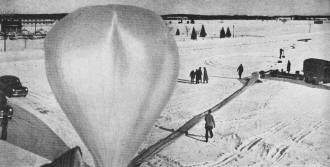
Helium is piped through thin, extruded-plastic
tube to form 17-foot bubble. Tapelike line stretching toward truck is rest of balloon
envelope. Helium-bottle dolly is at rear of truck.
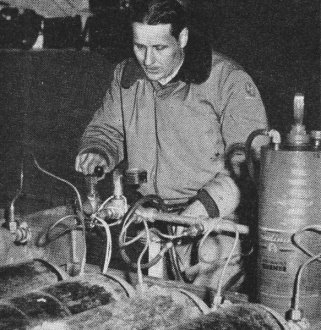
Flow of helium from steel bottles into manifold,
for piping to balloon envelope, is adjusted by technician. At start, only 1.3 percent
of the balloon's capacity is filled by the gas.

Plastic balloon skin, forwarded to PS by reporter
Francis, is polyethylene. It absorbs few infrared rays, and is unaffected by ultraviolet
light, unlike some plastics, or by temperature.
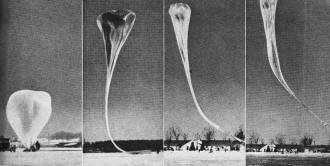
At launching, helium bubble sails up, picking
up load line. Apparatus weighing up to 70 lb. can be attached to it. Dark line seen
in the final picture, far right, is the parachute.

Full 206,000-cubic-foot capacity of bag, when
it has swollen to the size of several houses, is reached at 100,000 feet or so.
If winds are high, bag may be blown out of sight in an hour.
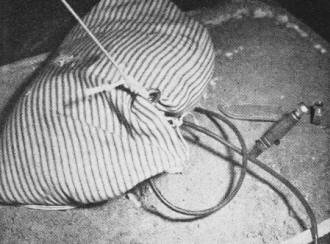
Sandbag at anchor conceals secret device for
cutting anchor line electrically at launching. Knife is used in emergency. Balloon
will rise above normal airplane traffic in 12 minutes.
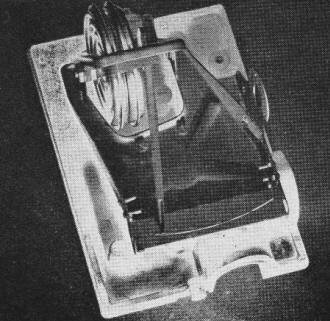
Aneroid cell - reliable only up to about 60,000
feet - uses air pressure to run this instrument that records altitude. During climb,
stylus etches line on glass coated with lamp black.
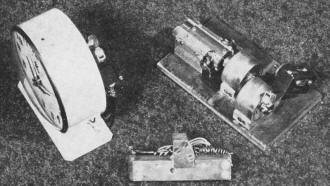
Either alarm clock, far left, or miniature,
battery-fed motor with reduction gear, far right, is used to time release of parachute.
Shown between them is load-line cutter. Upper-air research was started under auspices
of Special Devices Center, Office of Naval Research, Port Washington, N. Y.; is
directed by T. R. James, head of company's Aeronautical Research Lab.
Expansion did that. At 100,000 feet the air is only 1/100 as dense as it is at
sea level. The helium is pushing, seeking release, despite a temperature so low
that if a man were exposed to it he would die within a minute. Though the sun is
at its zenith, the balloon floats in darkness under a canopy of stars, for the darkness
at its altitude is eternal.
From a harness at its open end dangles a long load line, and to the line are
attached a limp parachute and a string of instruments. These instruments are all-important
- the balloon is only the vehicle used to deliver them to the altitude that scientists
want to explore.
Yet the balloon is the focal point of observation from the ground. That is because
the answers to the questions asked by chemists, physicists, and others depend on
its behavior. Presently an electric charge timed by a tiny motor will melt a bit
of wire, a razor-edged knife will sever the load line above the parachute, and the
instruments will start their long journey to the ground.
This is Project Skyhook. No explorations initiated in this postwar period
are more pregnant with meaning for the future than this one, carried out by General
Mills, Inc., of Minneapolis, for the United States Navy.
"Where our balloons now float," explained Otto C. Winzen, "will be man's highway
of tomorrow." He is the young engineer who started the project and brought it to
fruition for the Aeronautical Research Laboratories of General Mills.
Those balloons are probing a region that as yet is almost wholly unknown. A few
conditions up there have been discovered. It is bitter cold - yet the sun's rays
burn with fury far beyond that met anywhere on earth. Gravitational pull is practically
unchanged. Winds often exceed 100 m.p.h.
But what about the composition of the air? The effect of cosmic rays on man and
atomic structures? The speed of sound? What conditions will pilots encounter if
wars are fought at that altitude?
Airplanes can't supply the answers. They can't get much more than half that high.
Small rubber sounding balloons reach only the lower levels of the atmosphere. The
record for manned balloons is only 72,395 feet. Rockets streaking up and down through
this layer of the atmosphere go too fast to take adequate observations.
What is needed is an instrument platform that is relatively stable and motionless
in relation to the air - one that will reach and hold a precalculated ceiling of
around 20 miles for hours or even days.
Hence, a new kind of balloon. No balloon ever made before is like those of the
Aeronautical Research Laboratories. Their skin is tissue-thin. Yet these balloons
carry a "payload" of 7/10 of their empty weight.
Science's secret weapon in this assault on the unknown is a plastic, polyethylene
resin. Made by the Visking Corp., of Terre Haute, Ind., it weighs so little that
one strong man can lift a whole deflated balloon.
Radiosondes, parachutes, tiny radio transmitting stations, radar reflectors,
cosmic ray counters, special telemetering equipment, and other devices, about which
the government maintains secrecy, have been sent aloft under a single plastic bubble.
 Radiosonde contains, from
top, tiny radio sender, battery, and baro-switch unit. Switch, run by aneroid cell,
selects circuits for sending back temperature, humidity, and air pressure. Radiosonde contains, from
top, tiny radio sender, battery, and baro-switch unit. Switch, run by aneroid cell,
selects circuits for sending back temperature, humidity, and air pressure.
For excitement, the launching of a plastic balloon is the next thing to putting
your last two dollars on a long shot at Hialeah. The weather must be good for observation.
The wind cannot be too high: the plastic is fragile and subject to tearing.
First of all come safety precautions for other aircraft. The chances of collision
are remote, but the Civil Aeronautics Administration and the Weather Bureau are
advised of each Right in advance.
A ten-wheeled truck snakes a train of anchor boxes, special launching equipment,
a helium-bottle dolly, wiring for the electrical cutting of cords holding the load
line, and other paraphernalia onto the field, about a hundred miles from Minneapolis.
This permanent site was chosen because it is remote, free from intrusion, and off
the scheduled airways.
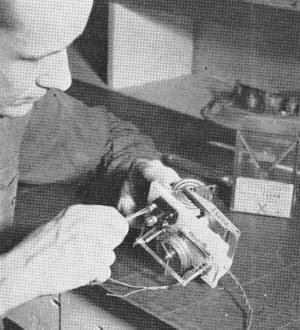
Aneroid-tripped electric light is hitched
to parachute to warn aircraft when descent is made after dark. Cell cocks on way
up, switches all flashing light at 20,000-foot level on way down.
The top of the balloon, where the helium bubble will develop, is laid out in
the lee of an unused airplane hangar to protect it from the wind. The rest of the
envelope is strung downwind with all the gentleness of a mother's caress. As an
extension of the downwind line, the load line, complete with its parachute and instruments,
is hung on forked standards and anchored by boxes of sand. The load line must be
put under exactly the right amount of tension. A slack line might cause an instrument
to snap off when the helium bubble is released. That has happened.
The input of gas is measured volumetrically. Wind velocity and direction are
checked minute by minute. If the wind shifts, the direction of takeoff must be aligned
with it.
Now is the time. A tube, also of plastic, which has been feeding helium to the
balloon is withdrawn. Wrenches close the gas bottles. The truck hauls away the dolly.
One man prepares to release the bubble. Two others stand within sprinting distance
of the anchor points - there may be an emergency. A hundred feet to the side a fourth
man will close successive circuits to chop the anchor cords.
The man in charge picks up a megaphone. "Set?" The men downwind respond individually
... "All set."
The bubble soars. As it picks up the folds, the balloon becomes a cobra. For
a second or two it writhes. It weaves. Now it has seized the load line. Up goes
the parachute. As fast as the tongue can name them off, instruments, radar screens,
radiosonde, and finally a bag of sand for ballast are airborne. The sand bag goes
along only if there is a shortage of instruments, sent in for the flights by colleges
and other institutions collaborating on fundamental upper-air research.
Tracking a Soaring Laboratory
The work has only begun. Now the balloon must be tracked. Its trajectory supplies
valuable meteorological data. One man goes to the theodolite. The rest of the crew
clumps upstairs to the field control tower above the hangar.
Tracking is going on in other places, too. Within a diamond-shaped" pattern 100
miles long and 60 wide, observers aground are sending in azimuth and elevation reports
as frequently as once a minute. Radio direction finders and radar equipment are
trained on the balloon. Four shortwave radio communication stations correlate all
this information, and it is entered on charts for future study.
Not much more than an hour has passed; the balloon has leveled off at about 100,000
feet, its ceiling. Through the theodolite telescope it looks like a translucent
pear, less than half the size of a pea. Its load is not visible. Even if the parachute
were large enough to be seen, its red color would reflect no light to the eye.
Hours of methodical receipt and entry of reports on the balloon's course go by.
Suddenly the man on the theodolite reports: "Parachute's cut loose! Balloon's in
four pieces!"
A telephone rings. "Right," says the man on duty, answering, "four pieces at
4:27. We caught it." That was an observer calling in. A voice pages the tower on
the short wave: "Broke into four pieces at 4:27."
Shock from inertia forces alone, induced by the balloon losing its load, destroys
the delicate envelope to keep it from wandering around aimlessly in the sky.
The day's chores are done now. In anywhere from a half hour to an hour the parachute
will touch the ground and collapse. Attached to the radiosonde are directions for
the finder: Please ship the parachute and instruments back. That system is unavoidable.
Only now and then can the parachute be tracked by radar.
Few parachutes and instruments have been lost, out of scores of flights. Some
remitters don't use their heads, of course. One cut a couple of precious shroud
lines off the parachute to wrap his package for the post office. Another man, a
trapper who stumbled on the gimmicks in the wilds of the north country, pulled his
gun and shot up a couple of instruments.
The project is still experimental in that research never ends. For example, around
70,000 feet the radio transmitters may begin arcing between terminals because the
air becomes too thin to act as a non-conductor. Something must be done about that.
Temperature-measuring equipment is also inadequate. It gives, not the temperature
of the free air, but that of the air plus solar radiation effect. No instruments
have yet been developed, to measure pressure and dew-point accurately between 80,000
and 100,000 feet and telemeter the data back.
These are details. The end product of upper air exploration is a better understanding
of our planet. Cosmic radiation and meteorological research alone will yield results
that will benefit all mankind.
That realization helps the men get their feet on the floor when the alarm goes
off at 3 a.m., signaling another day to fly a balloon.
Posted June 1, 2024
|



